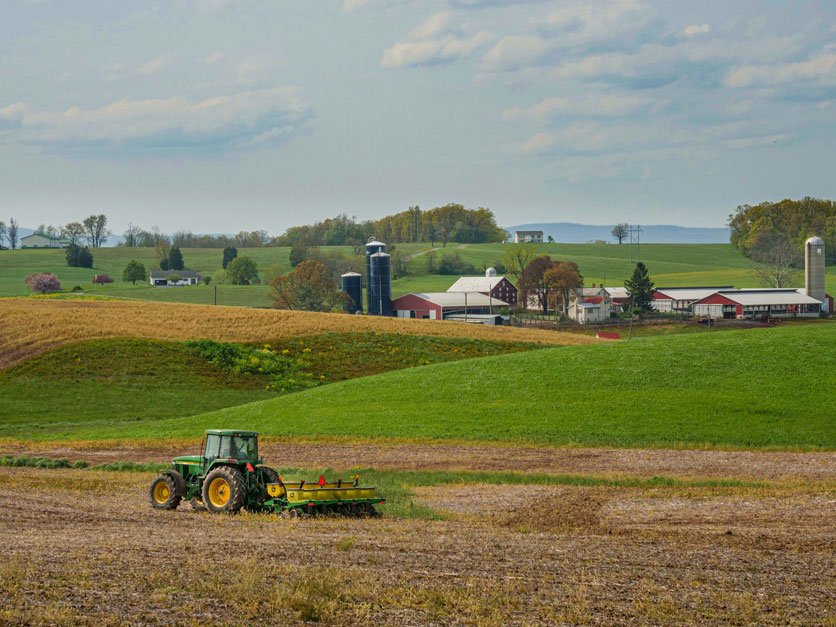The Agriculture Department issued a climate strategy Thursday that heavily focuses on measuring the impact of climate-friendly practices, taking steps to facilitate private carbon markets and ensuring all farmers can benefit financially from addressing climate change.
The climate plan, billed as a progress report that lays out broad goals and priorities and provides no specific policy proposals, makes no direct mention of establishing a carbon bank or using the department’s Commodity Credit Corp. spending authority to make payments to farmers.
The plan, which was developed at the direction of President Joe Biden, briefly suggests USDA could help support carbon credit prices but emphasizes the use of private markets to compensate farmers for carbon-conserving practices.
The report “addresses every aspect of the challenge that we have, and we’ll enlist all of the resources, tools and capacities that the Department of Agriculture has to enable agriculture to be part of the solution” to climate change, Ag Secretary Tom Vilsack said in an interview with Agri-Pulse.
“First and foremost we’re going to continue to make sure … that we have the tools — and that farmers have the tools — to be able to accurately assess the impact of the work they are currently doing and will do on the farm relative to greenhouse gas emissions.”
He said implementing the plan will require increased staffing and conservation technical assistance as well as more funding for agricultural research and conservation programs. There's also a need for new money to fund Biden’s proposed Civilian Climate Corps.
The plan calls for USDA to develop or improve existing methods for quantifying the carbon impacts of “climate-smart agriculture and forestry" (CSAF) practices and to track the benefits on a national scale. The department will set specific goals and bench marks for measuring progress on the adoption of conservation practices.
To encourage the wider use of such practices, the strategy calls for prioritizing the “climate risks, adaptation opportunities, and carbon benefits” provided by existing conservation programs, including the Environmental Quality Incentives Program, Conservation Stewardship Program, Agricultural Conservation Easement Program, and Conservation Reserve Program.
“USDA has already begun this work through the CRP by introducing a new Climate-Smart Practice Incentive that will increase sign-ups for the program while providing the opportunity to demonstrate “proof of concept” regarding CRP-related increases in carbon sequestration and reduced GHG emissions,” the strategy says.
The strategy also says conservation programs can be used to reward farmers who have already been following conservation practices, so-called “early adopters,” and may not qualify for carbon credits on private markets. Carbon credit purchasers generally want to pay only for greenhouse gas reductions that result from newly implemented practices.
The USDA plan says private carbon markets offer “great potential to finance large-scale adoption” of climate-friendly practices, and USDA has a role to play in making sure that farmers can benefit broadly.
USDA’s “multi-pronged approach” to facilitating those private markets could “include setting standards to reduce transaction costs; adopting science-based monitoring, reporting and verification approaches for CSAF practices; bolstering market infrastructure; or serving as a source of demand for agricultural carbon credits by setting clear price signals through price supports, loan programs or other financial tools that can help producers implement CSAF technologies,” the plan says.
Asked whether USDA was backing off the idea of a carbon bank, which has drawn opposition from congressional Republicans, Vilsack suggested the term wasn’t important.
Interested in more coverage and insights? Receive a free month of Agri-Pulse West
“I think I've used the word 'fund.' I think at the end of the day that the appropriate word is 'opportunity,'” he said.
“What kind of market opportunities can we create, and market opportunities can we develop, that would create partnerships between the government and the farmer, and potentially other investors, that enable farmers to sequester carbon, to avoid carbon, to reduce their emissions, and at the same time create additional income opportunities?”
There also is no direct mention in the plan of using the federal crop insurance program to incentivize conservation practices. Some groups have suggested implementing nationwide subsidy programs similar to popular programs now underway in Illinois and Iowa.
Vilsack said the strategy doesn’t preclude using crop insurance. “Our goal here is to utilize every tool that we have in a way to provide as much opportunity for farmers, reduce emissions to improve soil health and water quality and at the same time, maybe be profitable,” he said.
The plan also commits USDA to adjust programs to make sure that minority producers, tenant farmers and small-scale producers can participate.
That will require assessing the impacts “of farm size and land tenancy on participation; distributional effects of promoting certain CSAF practices; efficiency-equity trade-offs; and the particular needs of small-scale, family-owned, specialty crop, and socially disadvantaged producers,” the plan says.
USDA envisions a continued role for biofuels in addressing climate change, and says the industry could use policies such as California’s low carbon fuels standard and the 45Q tax credit for carbon capture and sequestration to further reduce the biofuel's carbon footprint.
"USDA should identify opportunities for agriculture and forestry to play a role in the production of low-carbon biofuel feedstocks, and for innovative technologies such as Biomass Energy with Carbon Capture (BECCS) to reduce emissions associated with biofuel production while spurring rural economic development," the plan says.
The blueprint takes note of more than 2,700 comments that USDA received from farm organizations, environmental groups and individuals on how the department should use new and existing programs, including crop insurance and conservation programs, to reduce greenhouse gas emissions.
Among the themes USDA found in the comments was that "a 'one-size-fits-all' policy or program will not work for all producers and land managers and that a CSAF strategy needs to be place-based, flexible, and locally-led," the plan says.
For more news, go to Agri-Pulse.com.



